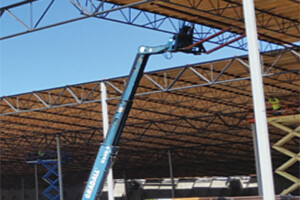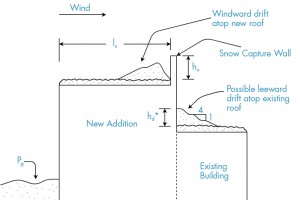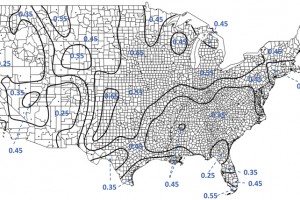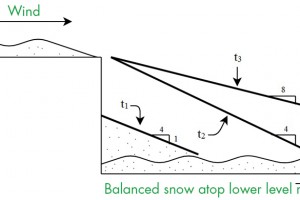As the name implies, a hybrid roof system combines plywood sheathing and wood sub-purlins supported by open web steel joists and joist girders. Hybrid roof systems offer a more sustainable alternative to metal deck systems. In addition, depending on the market, hybrid roofs can be more cost-effective and faster to build than metal deck roofs. This article investigates hybrid roofs under light to heavy uniform and non-uniform snow loads throughout the Mainland U.S. Sheathing thickness, rafter size, and rafter spacing are adjusted accordingly to provide adequate strength and stiffness. The findings are presented in color-coded maps, enabling owners, architects, and engineers to make instant and accurate decisions.
…Review Category : Structural Loads
Part 2
The American Society of Civil Engineers’ ASCE 7-22 load standard, Minimum Design Loads for Buildings and Other Structures, is now available, and substantive changes have been made to both the snow and rain provisions. This article is the second in a two-part series regarding these changes. Part 1 (STRUCTURE, January 2022) reviewed changes to the ground snow loads, which represents a shift away from uniform hazard to uniform risk, and the addition of a winter wind parameter to account for the variability in winter wind speeds on drift loads. This article reviews other revisions to the snow loads, including a more accurate estimation of the horizontal extent of windward drifts, revised thermal factors Ct to account for current trends in roof insulation and venting, and guidance on design loads for snow capture walls added to this edition. Also, changes were made to Chapter 8 to include a ponding head to the rain load, which provides a consistent approach to assess ponding.
…Part 1
The American Society of Civil Engineer’s ASCE 7-22 load standard, Minimum Design Loads for Buildings and Other Structures, is now available. Substantive changes have been made to the snow and rain provisions within the standard. In particular, the ground snow loads have been revised to reflect more recent snow load data and reliability-targeted values. In addition, the method for estimating drifts has been revised to include a wind parameter, and the procedure for determining design rain loads has been revised to explicitly consider a ponding head. Some of the more substantive changes are discussed, along with the reasons for these changes. This article is Part 1 of a two-part series and reviews the new ground snow loads and a new winter wind parameter. Part 2 will include the other more substantive changes to the snow load provisions and the new rain load provisions.
…One could argue that drift loads are the most important snow load since they account for roughly 75% of all snow-related structural problems. The various types of roof snowdrifts are reasonably well understood. However, a new snowdrift was recently observed downwind of a run of roof-top refrigeration piping, which did not seem consistent with our current understanding of snowdrift formation. In this article, the drift formation processes for four common snowdrifts – leeward roof step drifts, gable roof drifts, windward roof step drift, and parapet wall/roof projection drifts – are reviewed as well as the apparent formation process for the new roof-top piping-run drift. Finally, an explanation for the apparent inconsistency between the new piping-run drift and common drifts is provided.
…



